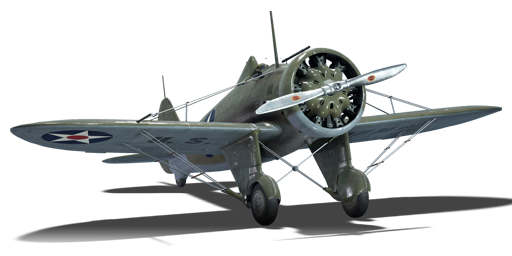

In 1932, before testing with the XP-936 was done, the U.S. Army issued a statement for an improved XP-936 for production. Only a year later, the USAAC ordered over 100 examples with the designation P-26A. It was to be fitted with the Pratt & Whitney R-1340-27 Wasp radial engine that also boasted a supercharger. The R-1340-27 made around 500 hp but later variants made 600 hp. P-26As were delivered not long after and proved to be a decently advanced aircraft for its time.
The P-26A-34 M2 has been in the game since the start of the Open Beta Test prior to Update 1.27. Although the P-26 is a monoplane, it has an impressive turn radius but biplanes are still far better in terms of turning. Unlike the other P-26s, this specific variant of the P-26 has a 12.7 mm machine gun which is a big improvement over the standard 7.62 mm machine gun it replaced. It packs a much larger punch, more range, and takes more time to overheat. It also has the landing flaps which were eventually fitted to all P-26 variants.
flaps
flaps
flaps
brake
control
| Belt | Belt filling | Armor penetration (mm) at a distance: | |||||
|---|---|---|---|---|---|---|---|
| 10 m | 100 m | 500 m | 1000 m | 1500 m | 2000 m | ||
| T/Ball/I/AP | 30 | 27 | 20 | 13 | 9 | 6 | |
| T/AP/AP/I | 30 | 27 | 20 | 13 | 9 | 6 | |
| T/AP/AP/AP | 30 | 27 | 20 | 13 | 9 | 6 | |
| T/T/AP | 30 | 27 | 20 | 13 | 9 | 6 | |
| AP/I/AP | 30 | 27 | 20 | 13 | 9 | 6 | |
| Belt | Belt filling | Armor penetration (mm) at a distance: | |||||
|---|---|---|---|---|---|---|---|
| 10 m | 100 m | 500 m | 1000 m | 1500 m | 2000 m | ||
| T/AP/AP/AP/I | 13 | 12 | 7 | 3 | 2 | 0 | |
| T/AP/I | 13 | 12 | 7 | 3 | 2 | 0 | |
| AP/T/T | 13 | 12 | 7 | 3 | 2 | 0 | |
| AP/AP/I/I | 13 | 12 | 7 | 3 | 2 | 0 | |








Flight performance | |
|---|---|
Survivability |
|---|
Weaponry | |
|---|---|